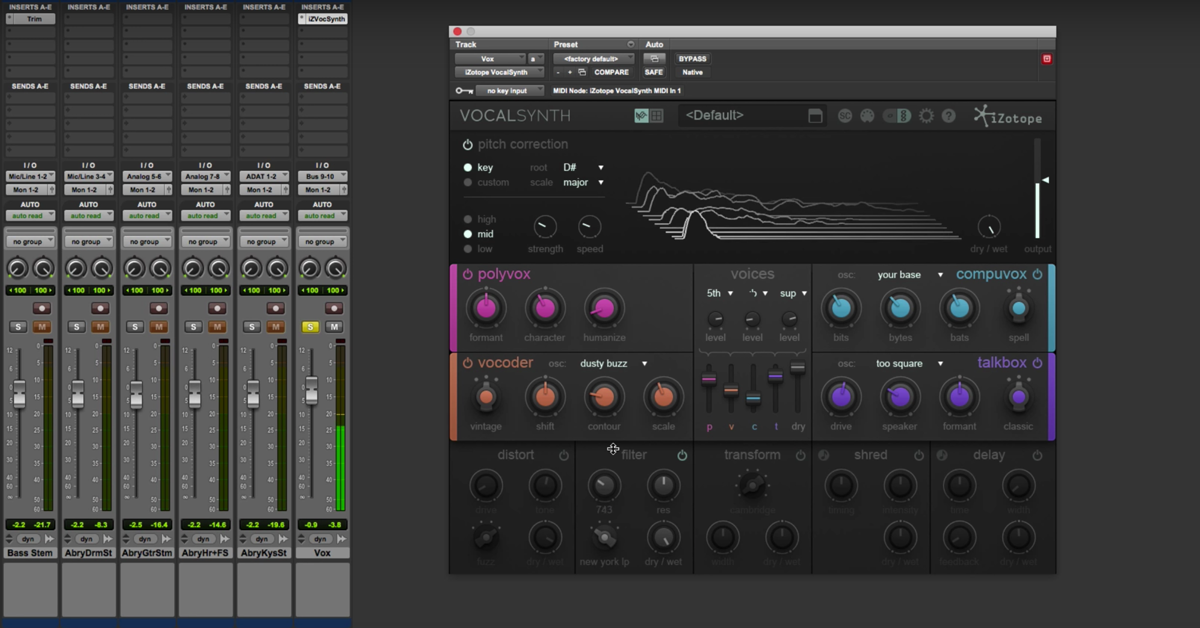Introduction to Granular Synthesis
Article Content
Granular Synthesis, a method once restricted to offline processing due to the limitations of CPUs, is now prevalent and widely used in many plugins and DAWs. As processing speeds have increased exponentially, many virtual instruments and effects plugins have emerged that make use of this very powerful technique.
The most common uses are those that involve the real-time independent manipulation of sound file speed, pitch and duration such as in Melodyne, Auto-Tune, and Ableton’s warping functions to name a few.
Overview of Granular Synthesis
Curtis Roads recognized that light can be observed as having both wavelike and particulate properties (photons). Likewise, a continuous sound can be composed from a collection of very short acoustic events. (Roads 168) Iannis Xenakis was the first composer to use granular ideas using analog tone generators and tape splicing.
“Granular synthesis can be implemented with a simple synthesis instrument: a sine wave oscillator controlled by an envelope generator.” (Roads 171)
As simple as this sounds, it could take thousands of parameters per second to describe each grain, which are chunks of sound, typically 1 to 100ms in duration. In the case of manipulating an existing sound, the file would be sliced or divided into grains. Once divided, each grain can be manipulated independently, reordered, reversed, etc. This type of time granulation as applied to sampled sounds should be distinguished from grain generation, which starts with a waveform, amplitude, starting time, and frequency. Some approaches to time granulation include:
Replication: where a grain is extracted and repeated
Reordering: where grains are extracted and reordered
Merging and Reordering: where grains are extracted from multiple sources and combined
In all cases, grains can be overlapped and delayed, and “spectral side effects can distort and enrich the sound in a controllable way.” (Roads 184)
Amplitude envelopes are applied to grains which can be smoothly connected at zero-point crossings. This is “somewhat analogous to the way film projectors work. By presenting a series of slightly different still images at a rate that is just about the limit of the eye’s response to changes, the impression is one of a smooth continuous movement.” (Russ 294)
So by combining thousands of grains we can create a continuous spectrum and sonic texture.
In effect, time granulation is inherent to the idea of windowing in Fast Fourier Transform (FFT) type processes, which are also used for time/compression, pitch-shifting, analysis, and digital noise reduction.
Synchronous Granular Synthesis
In this method, grains are separated by the same amount of time and is closely related to FOF (Formant Synthesis), where FFT processes are used with sinusoidal contents. The main parameters in this method include:
Amplitude: an envelope over the entire duration of the texture
Grain Density: the number of grains per second and perhaps the most influential parameter
“The Grain density affects the timbre, the amplitude and the pitch of the texture. A sparse density of less than 30 grains per second will create a rhythmic effect. As the density increases the distinction of any rhythm will be lost and will give way to a pitch sensation determined by the grains. The higher the density the greater the spectral complexity of the timbre. Denser textures will yield more partials, formants and side bands in the texture making them richer. The amplitude will increase as the density increases. The pitch will rise as the density rises. There is a direct relationship between grain density and grain duration. The longer the grains are, the more they will overlap making the texture denser at lower grain density rates.” (Opie)
Pitch: can be changed by playing back grains at various sampling rates or increasing grain density.
Inter-onset Time is a function of grain density and is more of an indicator rather than a parameter.
Asynchronous Granular Synthesis
In this method, grains do not have to follow a strict linear relationship and can be reordered from the original context. The main parameters in this method include:
Amplitude: an envelope over the entire duration of the texture
Grain Density: a time parameter that specifies a period in which grains are dispersed.
Pitch: can be changed by playing back grains at various sampling rates.
Inter-Onset Time: “This is a measurement of the duration between the beginnings of adjacent grains and as such would change constantly. Asynchronicity can be achieved by setting up a random or statistical inter-onset parameter.” (Opie)
Select Instruments and Effects Using Granular Synthesis
- Ableton (Tempo Warping)
- Absynth (Native Instruments)
- Alchemy (Logic Pro)
- Arkana (Quadelectra)
- Auto-Tune (Antares)
- Dynamic Delay (iZotope)
- Fruity Granulizer (FL Studio)
- Grain Delay (Ableton)
- Granite (AU/VST/Standalone)
- Granular Lab (Amazing Noises – Max for Live)
- Granulator II (Ableton)
- Kontakt (Native Instruments)
- Logic Pro (Flextime)
- Malström (Propellerheads)
- Melodyne (Celemony)
- Omnisphere 2 (Spectrasonics)
- Pro Tools (Elastic Audio)
- Reaktor (Native Instruments)
Select iOS Apps Using Granular Synthesis
Borderlands has a particularly interesting interface that takes full advantage of the multitouch functionality of the iPad.
The subject is deep and much has been written about it, so I’ve included a short bibliography below for your edification and amusement. Aside from the obvious benefits of independent pitch and time manipulation, Granular Synthesis is ripe with sound design possibilities and fertile ground for experimentation.
Check out my other articles, reviews and interviews
Follow me on Twitter / Instagram / YouTube
References






